Intel SSD 520 Review: Cherryville Brings Reliability to SandForce
by Anand Lal Shimpi on February 6, 2012 11:00 AM ESTAnandTech Storage Bench 2011
Last year we introduced our AnandTech Storage Bench, a suite of benchmarks that took traces of real OS/application usage and played them back in a repeatable manner. I assembled the traces myself out of frustration with the majority of what we have today in terms of SSD benchmarks.
Although the AnandTech Storage Bench tests did a good job of characterizing SSD performance, they weren't stressful enough. All of the tests performed less than 10GB of reads/writes and typically involved only 4GB of writes specifically. That's not even enough exceed the spare area on most SSDs. Most canned SSD benchmarks don't even come close to writing a single gigabyte of data, but that doesn't mean that simply writing 4GB is acceptable.
Originally I kept the benchmarks short enough that they wouldn't be a burden to run (~30 minutes) but long enough that they were representative of what a power user might do with their system.
Not too long ago I tweeted that I had created what I referred to as the Mother of All SSD Benchmarks (MOASB). Rather than only writing 4GB of data to the drive, this benchmark writes 106.32GB. It's the load you'd put on a drive after nearly two weeks of constant usage. And it takes a *long* time to run.
1) The MOASB, officially called AnandTech Storage Bench 2011 - Heavy Workload, mainly focuses on the times when your I/O activity is the highest. There is a lot of downloading and application installing that happens during the course of this test. My thinking was that it's during application installs, file copies, downloading and multitasking with all of this that you can really notice performance differences between drives.
2) I tried to cover as many bases as possible with the software I incorporated into this test. There's a lot of photo editing in Photoshop, HTML editing in Dreamweaver, web browsing, game playing/level loading (Starcraft II & WoW are both a part of the test) as well as general use stuff (application installing, virus scanning). I included a large amount of email downloading, document creation and editing as well. To top it all off I even use Visual Studio 2008 to build Chromium during the test.
The test has 2,168,893 read operations and 1,783,447 write operations. The IO breakdown is as follows:
| AnandTech Storage Bench 2011 - Heavy Workload IO Breakdown | ||||
| IO Size | % of Total | |||
| 4KB | 28% | |||
| 16KB | 10% | |||
| 32KB | 10% | |||
| 64KB | 4% | |||
Only 42% of all operations are sequential, the rest range from pseudo to fully random (with most falling in the pseudo-random category). Average queue depth is 4.625 IOs, with 59% of operations taking place in an IO queue of 1.
Many of you have asked for a better way to really characterize performance. Simply looking at IOPS doesn't really say much. As a result I'm going to be presenting Storage Bench 2011 data in a slightly different way. We'll have performance represented as Average MB/s, with higher numbers being better. At the same time I'll be reporting how long the SSD was busy while running this test. These disk busy graphs will show you exactly how much time was shaved off by using a faster drive vs. a slower one during the course of this test. Finally, I will also break out performance into reads, writes and combined. The reason I do this is to help balance out the fact that this test is unusually write intensive, which can often hide the benefits of a drive with good read performance.
There's also a new light workload for 2011. This is a far more reasonable, typical every day use case benchmark. Lots of web browsing, photo editing (but with a greater focus on photo consumption), video playback as well as some application installs and gaming. This test isn't nearly as write intensive as the MOASB but it's still multiple times more write intensive than what we were running last year.
As always I don't believe that these two benchmarks alone are enough to characterize the performance of a drive, but hopefully along with the rest of our tests they will help provide a better idea.
The testbed for Storage Bench 2011 has changed as well. We're now using a Sandy Bridge platform with full 6Gbps support for these tests.
AnandTech Storage Bench 2011 - Heavy Workload
We'll start out by looking at average data rate throughout our new heavy workload test:
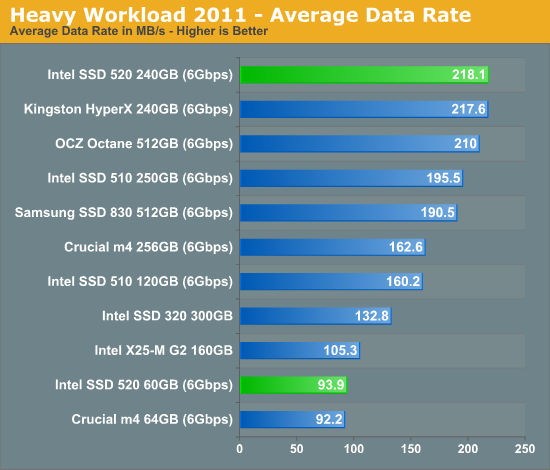
SandForce has always done well in our Heavy Workload test, and the 520 is no different. For heavy multitasking workloads, the 520 is the fastest SSD money can buy. Note that its only hindrance is incompressible write speed, which we do get a hint of in our breakdown of read/write performance below.

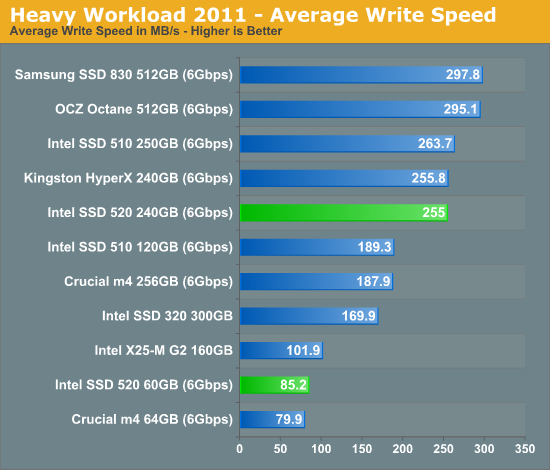
The next three charts just represent the same data, but in a different manner. Instead of looking at average data rate, we're looking at how long the disk was busy for during this entire test. Note that disk busy time excludes any and all idles, this is just how long the SSD was busy doing something:
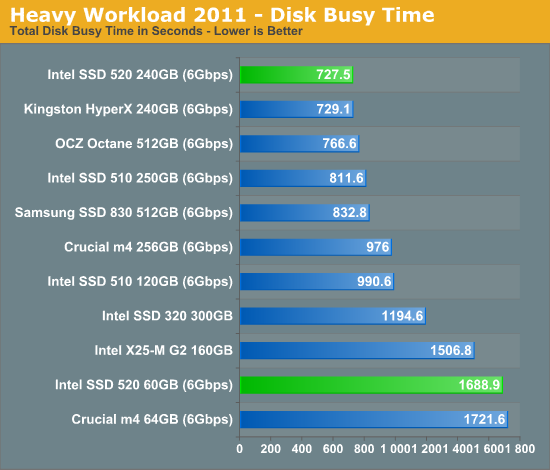
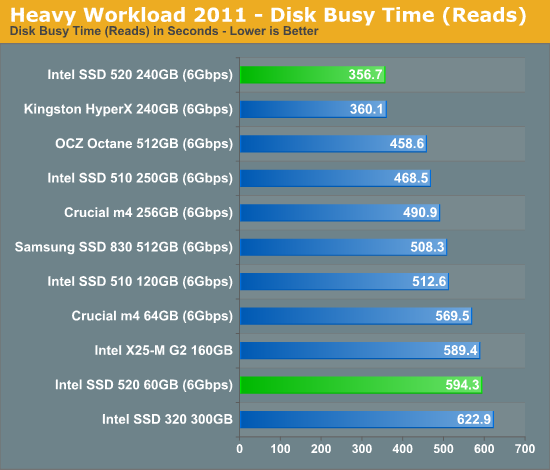
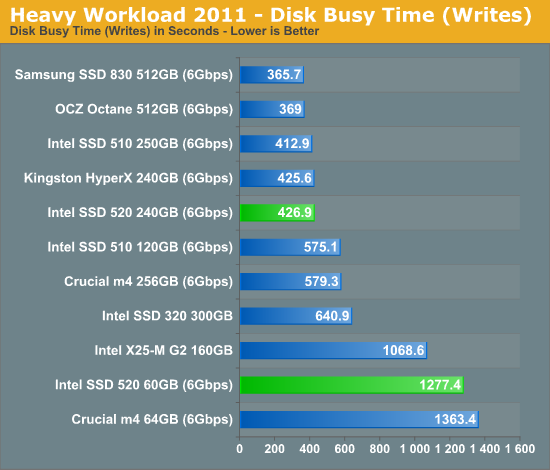










138 Comments
View All Comments
AnnoD - Monday, February 6, 2012 - link
Well I'm sorry, but... As positive as the conclusion is, to me this all sounds like Intel has found a way of hampering the competition. (I almost put "a new way" in that sentence instead, but I don't want to fire of wars...) How ethical is all this really? Is Intel putting effort into bugfixing itself, having SandForce doing the same work but with less manpower? Or are they actually not allowing to fix what Intel fixed for a while? I think this should not be so easily overlooked!quanstro - Monday, February 6, 2012 - link
i'm not sure how one could say that intel is morally obligated to give competitors the results of a year's testing. or that the competition has lost anything. if intel had not done the validation work, competitors would have exactly the same benefit from intel. would that also be stifling the competition?spazoid - Monday, February 6, 2012 - link
Do you expect Intel to give their findings and bug fixes away for free? Why would they do that? Do you have ANY examples of that happening outside of the open source community?Sunrise089 - Monday, February 6, 2012 - link
Yeah, I sure wish I had one fewer drive to chose from, especially if that one was the most reliable! All in the name of "fairness." ;)DanSmith - Tuesday, February 7, 2012 - link
Well thats how business works. Guessing you own a drive with a buggy SF controller from a competitor. Intel spent a year funded testing and bug fixing a controller they bought the rights to use so they get the benifit. Bet you OCZ have a similar deal but dont have the man power (or desire) to so thoroughly test.I know my time (and my companies downtime) is worth much more than the extra % for an SSD from a similar ilk as the x-25 and 320 series. As a sysadmin the thought of ever putting low cost consumer SSDs in production systems would keep me awake at night!
I will be getting a few of these to evaluate for sure.
Morg. - Tuesday, February 7, 2012 - link
You're (like anandtech) overrating Intel's edge w/ their firmware.At best they've got a few more resolved firmware issues than the default SF firmware.
Who cares ?
And most of all, who cares about a late and expensive third gen drive when the biggest issue with its direct competitors is that *some* of them cause problems.
Overall the 520 is a failure as a product and a resounding marketing success, as all of Intel's sponsored reviewers have an easy "real" story to tell. (like we had a 2281 that failed, put in the Intel one and boom it worked ... never tried another 2281, never tried another controller ... but who cares, let's buy overpriced intel)
seapeople - Tuesday, February 7, 2012 - link
Yes, it's a huge failure for a product to not only equal the fastest drives on the market today in performance, but to do so while besting them all in reliability and stability.Where's my sarcasm font?
MrSpadge - Monday, February 6, 2012 - link
Since it's ~50% higher on the Intel drive and the BSOD issues seem related to power management, I suspect Intel turned part of the power management off.MrS
coder543 - Tuesday, February 7, 2012 - link
yet somehow they aren't terribly power inefficient.Hauk - Monday, February 6, 2012 - link
Intel can you fix my OCZ Vertex 3 drives? They don't see to be as reliable as my old G2's..